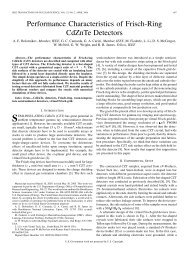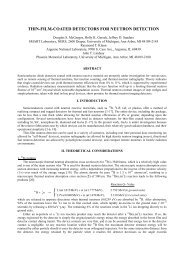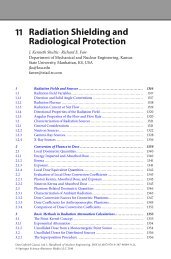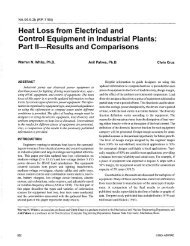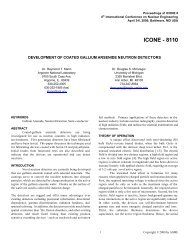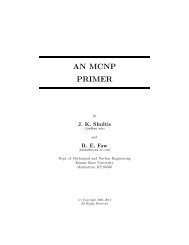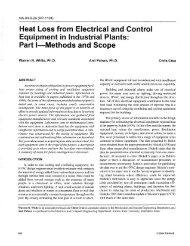Carbon coating of fused silica ampoules - Kansas State University ...
Carbon coating of fused silica ampoules - Kansas State University ...
Carbon coating of fused silica ampoules - Kansas State University ...
You also want an ePaper? Increase the reach of your titles
YUMPU automatically turns print PDFs into web optimized ePapers that Google loves.
ARTICLE IN PRESS<br />
Journal <strong>of</strong> Crystal Growth 290 (2006) 597–601<br />
www.elsevier.com/locate/jcrysgro<br />
<strong>Carbon</strong> <strong>coating</strong> <strong>of</strong> <strong>fused</strong> <strong>silica</strong> <strong>ampoules</strong><br />
Mark J. Harrison, Adam P. Graebner, Walter J. McNeil, Douglas S. McGregor <br />
S.M.A.R.T. Laboratory, Department <strong>of</strong> Mechanical and Nuclear Engineering, <strong>Kansas</strong> <strong>State</strong> <strong>University</strong>, Manhattan, KS 66506, USA<br />
Received 22 September 2005; received in revised form 5 January 2006; accepted 10 January 2006<br />
Available online 20 March 2006<br />
Communicated by T. Hibiya<br />
Abstract<br />
A reliable method for depositing a layer <strong>of</strong> carbon on the inner walls <strong>of</strong> a <strong>fused</strong> <strong>silica</strong> ampoule is described and characterized. <strong>Carbon</strong><br />
deposition rates were found to be 0.33 mm/h at mid-length and range from 0.26 to 0.55 mm/h at the ends <strong>of</strong> a 150 mm long ampoule.<br />
Deposition rate was found to vary along the length <strong>of</strong> the ampoule, but not along the radial perimeter.<br />
r 2006 Elsevier B.V. All rights reserved.<br />
Keywords: A1. Ampoule preparation; A1. <strong>Carbon</strong> <strong>coating</strong>; A2. Growth from melt; B1. Quartz<br />
1. Introduction<br />
Fused synthetic <strong>silica</strong> (quartz) is <strong>of</strong>ten used in the<br />
construction <strong>of</strong> the crucible or ampoule in crystal growth<br />
or materials purification applications for a number <strong>of</strong><br />
reasons. Quartz is readily available in very pure form while<br />
possessing the ability to withstand high temperatures and<br />
high thermal gradients. The material also maintains good<br />
mechanical strength at elevated temperatures. However,<br />
for all <strong>of</strong> the beneficial properties <strong>of</strong> quartz, devitrification<br />
and other deleterious effects occur in the presence <strong>of</strong> some<br />
materials.<br />
Certain processes benefit from a thin <strong>coating</strong> <strong>of</strong> carbon<br />
deposited on the quartz sidewalls as the carbon can act as a<br />
scavenger <strong>of</strong> oxygen (O 2 ) and water (H 2 O) impurities and<br />
as a protective buffer between the material <strong>of</strong> concern and<br />
the quartz [1]. In the case <strong>of</strong> Bridgman growth <strong>of</strong> cadmium<br />
telluride (CdTe) or cadmium zinc telluride (CdZnTe), the<br />
ingot tends to adhere to the sidewalls <strong>of</strong> the quartz vessel in<br />
which it is grown. Presumably, cadmium oxide (CdO)<br />
reacts with the silicon in the sidewall to form cadmium<br />
meta<strong>silica</strong>te (CdSiO 3 ) [1]. However, at elevated temperatures,<br />
carbon reacts easily with O 2 and H 2 O to form carbon<br />
dioxide (CO 2 ) and carbon monoxide (CO), thus tying up<br />
otherwise free O 2 molecules. Without the presence <strong>of</strong> free<br />
Corresponding author. Tel.: +1 785 532 5284; fax: +1 785 532 7057.<br />
E-mail address: mcgregor@ksu.edu (D.S. McGregor).<br />
oxygen, the reaction between CdO and quartz is much less<br />
severe since CdO does not initially form. Therefore, the<br />
inclusion <strong>of</strong> carbon within the ampoule serves two<br />
purposes. The first purpose is to getter any O 2 or H 2 O.<br />
Second, the carbon layer physically prevents CdO from<br />
contacting the inner ampoule walls. Similar benefits are<br />
reported for the growth <strong>of</strong> copper indium selenide<br />
(CuInSe 2 ) [2].<br />
The carbon <strong>coating</strong> process and its effects on crystal<br />
growth are mentioned several times in the literature [1–9].<br />
However, a definitive procedure for obtaining uniform,<br />
adherent <strong>coating</strong>s <strong>of</strong> carbon is not present. This work<br />
describes a reliable, reproducible carbon <strong>coating</strong> technique<br />
and presents data regarding the thickness <strong>of</strong> <strong>coating</strong>s at<br />
various locations along the ampoule.<br />
2. Experimental procedure<br />
The process described here requires four basic steps:<br />
ampoule cleaning, ampoule annealing, carbon deposition,<br />
and film annealing. The cleaning and annealing procedures<br />
were found to greatly impact carbon film quality and are<br />
therefore included. <strong>Carbon</strong> deposition is the process <strong>of</strong><br />
cracking hydrocarbon molecules to produce an amorphous<br />
carbon layer. The deposited carbon film must be then<br />
heated to sufficiently high temperatures to densify the layer<br />
into a glass-like form <strong>of</strong> lower porosity. Each <strong>of</strong> these four<br />
steps for obtaining a uniform, well-adhered carbon film on<br />
0022-0248/$ - see front matter r 2006 Elsevier B.V. All rights reserved.<br />
doi:10.1016/j.jcrysgro.2006.01.014
598<br />
ARTICLE IN PRESS<br />
M.J. Harrison et al. / Journal <strong>of</strong> Crystal Growth 290 (2006) 597–601<br />
the inner walls <strong>of</strong> a quartz ampoule is explained in detail in<br />
the following sections.<br />
A total <strong>of</strong> four quartz <strong>ampoules</strong> were used in studying<br />
this process. All <strong>ampoules</strong> were built by Technical Glass<br />
Products, Inc. to specified dimensions using high-purity<br />
quartz stock. A cross-sectional view <strong>of</strong> the ampoule design<br />
is given in Fig. 1 with the specified dimensions. The<br />
rounded end nearest point D is referred to as the bottom,<br />
because <strong>of</strong> the ampoule’s orientation during vertical<br />
Bridgman crystal growth. Each ampoule had a main<br />
chamber constructed <strong>of</strong> 25 28 mm quartz tube with a<br />
short support rod at the bottom and a 3 8<br />
in inlet tube on the<br />
opposite end. While the <strong>ampoules</strong> used here had a<br />
hemispherical bottom end, the <strong>ampoules</strong> used for crystal<br />
growth purposes usually utilize conical ends to aid in grain<br />
seeding. No differences in carbon <strong>coating</strong> <strong>of</strong> either design<br />
have been noted. The interior <strong>of</strong> the ampoule was not<br />
roughened, unlike in literature elsewhere [9].<br />
2.1. Cleaning<br />
Each ampoule was, in turn, cleaned within a Class 1000<br />
cleanroom using a series <strong>of</strong> etches and rinses designed to<br />
minimize impurities within the ampoule. The steps for<br />
cleaning are listed in Table 1. All glassware used to prepare<br />
the solutions was cleaned in the same manner as the<br />
ampoule prior to use. Upon completion <strong>of</strong> the cleaning<br />
steps, the inlet tube was sealed using Parafilm and the outer<br />
surface <strong>of</strong> the ampoule wiped with isopropanol prior to<br />
being removed from the cleanroom. Any ampoule handling<br />
after this point was done by touching the bottom rod or<br />
inlet stem with nitrile gloves, never the outer walls <strong>of</strong> the<br />
main chamber.<br />
2.2. Ampoule annealing<br />
Next, each ampoule was inserted into a three-zone<br />
horizontal clamshell furnace for processing immediately<br />
after being cleaned. The main chamber <strong>of</strong> each ampoule<br />
was placed within the center zone (Zone 2) <strong>of</strong> the furnace<br />
as depicted in Fig. 2. The inlet tube extended out <strong>of</strong> one<br />
end <strong>of</strong> the furnace. To ensure uniform heating, the<br />
ampoule was centered within the furnace by placing<br />
alumina insulation rings around the support rod and the<br />
inlet tube on either side <strong>of</strong> the main chamber. Two more<br />
alumina rings were also placed around the inlet tube at<br />
equal intervals along its length to help reduce sag at the<br />
high processing temperatures.<br />
A series <strong>of</strong> stainless steel fittings were next attached to<br />
the inlet tube. A larger diagram <strong>of</strong> the arrangement is<br />
shown in Fig. 3. This set <strong>of</strong> fittings played several<br />
important roles. Moving to the left from seal 1, the<br />
first component was an ‘‘Inlet Ball Valve’’ <strong>of</strong> sufficient<br />
diameter to allow a small 2 3 mm quartz tube to<br />
pass through when the valve was open. Next, a tee<br />
allowed an exhaust for flow gases. Finally, seal 2 sealed<br />
around the 2 3 mm tube. The 2 3 mm quartz tube was<br />
used to insert gases into the ampoule and was approximately<br />
the same length as the ampoule and fittings<br />
combined. This ‘‘gas insertion tube’’ was inserted into the<br />
ampoule leaving 25 mm <strong>of</strong> clearance between the bottom<br />
end <strong>of</strong> the ampoule and the exit point <strong>of</strong> the gas insertion<br />
tube. A gas line was finally sealed onto the gas insertion<br />
tube to the left <strong>of</strong> seal 2.<br />
Fig. 1. Cross-sectional view <strong>of</strong> quartz ampoule. Points A–D denote<br />
positions which were measured for carbon thickness.<br />
Table 1<br />
Step<br />
Description<br />
Fig. 2. Cross-sectional view <strong>of</strong> ampoule within the three zone tube<br />
furnace.<br />
1 Rinsed 6 times with deionized water (DI H 2 O)<br />
2 Etched for 15 min with 1:1:1 H 2 SO 4 :H 2 O 2 :DI H 2 O solution at<br />
room temperature (RI)<br />
3 Rinsed 6 times with DI H 2 O<br />
4 Etched for 2.5 h with potassium dichromate acid at RT<br />
5 Rinsed 6 times with DI H 2 O<br />
6 Etched for 4 h with 5% HF/DI H 2 O solution at RT<br />
7 Rinsed 6 times with DI H 2 O<br />
8 Rinsed 4 times with Certified ACS (American Chemical<br />
Society) grade isopropanol<br />
Fig. 3. Cross-sectional view <strong>of</strong> the gas insertion tube sealing apparatus.
ARTICLE IN PRESS<br />
M.J. Harrison et al. / Journal <strong>of</strong> Crystal Growth 290 (2006) 597–601 599<br />
Fig. 4. Piping and instrumentation diagram <strong>of</strong> the gas flow apparatus.<br />
Once mounted, the ampoule was ready to be annealed.<br />
To begin, ultra-high-purity (UHP) argon was used to purge<br />
the ampoule <strong>of</strong> any residual isopropanol or water using a<br />
flow rate <strong>of</strong> approximately 100 mL/min. During the<br />
purging, the furnace was ramped to 1160 1C at a rate <strong>of</strong><br />
3 1C/min. Fig. 4 depicts the arrangement <strong>of</strong> valving and<br />
instrumentation used to achieve the gas flows and flow<br />
rates described. When the furnace reached 200 1C, the<br />
argon flow rate was reduced to 15 mL/min. Once the<br />
furnace reached 1160 1C, the temperature and gas flow rate<br />
were held constant for at least 8 h to anneal the quartz.<br />
2.3. <strong>Carbon</strong> deposition<br />
Upon completion <strong>of</strong> the annealing step, the furnace<br />
temperature was lowered to the carbon deposition temperature<br />
<strong>of</strong> 700 1C at a rate <strong>of</strong> 1 1C/min to avoid<br />
introducing stress back into the ampoule as it cooled.<br />
When 700 1C had been reached, the argon flow was<br />
switched to an UHP nitrogen (N 2 ) gas flow <strong>of</strong> 15 mL/<br />
min. For 1 h, temperature and N 2 gas flow were held<br />
constant to purge the ampoule <strong>of</strong> argon and ensure the<br />
temperature field was near or at an equilibrium <strong>of</strong> 700 1C.<br />
<strong>Carbon</strong> deposition was started by diverting the N 2 gas<br />
flow from bypassing the hexane bubbler to flowing through<br />
the bubbler to begin carrying hexane into the heated<br />
ampoule. N 2 flow was held constant at 15 mL/min for the<br />
duration <strong>of</strong> the deposition period. The duration <strong>of</strong> this<br />
deposition step was varied for the purposes <strong>of</strong> this<br />
thickness study and was set at 1 2<br />
, 1, 2, and 3 h long for<br />
the four <strong>ampoules</strong>. Spectrophotometric hexane was chosen<br />
as the hydrocarbon for carbon deposition as it is readily<br />
available in high-purity form and contains no oxygen at the<br />
molecular level. However, other hydrocarbons such as<br />
acetone, propane, isopropanol, and methanol have been<br />
used with success by others in different carbon <strong>coating</strong><br />
processes [10].<br />
continued to flow at 15 mL/min to maintain a positive<br />
pressure on the system, seal 2 was detached from the outlet<br />
tee. The gas insertion tube was then slowly removed. As<br />
soon as the end <strong>of</strong> the gas insertion tube cleared the inlet<br />
valve, the inlet ball valve was closed. N 2 flow was stopped<br />
and the gas insertion tube was fully removed from the<br />
fittings. Next, the outlet tee was disconnected from the inlet<br />
valve and removed from the system. A mechanical roughing<br />
pump was then connected to the inlet valve. The<br />
vacuum pump was switched on and the foreline was<br />
pumped down to less than 150 mTorr. Over a period <strong>of</strong><br />
several minutes, the inlet valve was slowly opened to<br />
evacuate the ampoule. The system pressure stabilized at<br />
150 mTorr after several minutes <strong>of</strong> pumping. The furnace<br />
was next ramped from the deposition temperature <strong>of</strong><br />
700 1C to the film annealing temperature <strong>of</strong> 1150 1Cat31C/<br />
min. The ampoule was held at 1150 1C under a vacuum <strong>of</strong><br />
150 mTorr for 2 h to anneal the carbon film.<br />
Once annealing was completed, the furnace was ramped<br />
down to room temperature at 1 1C/min. When the furnace<br />
had reached a temperature <strong>of</strong> less than 100 1C, the inlet<br />
valve was closed again and the vacuum pump detached.<br />
Argon flow was again introduced to the system to backfill<br />
the ampoule to atmospheric pressure.<br />
3. Results<br />
The carbon-coated <strong>ampoules</strong> appeared as shown in<br />
Fig. 5 when removed from the furnace. Samples located at<br />
points A–D were cut from each ampoule using a diamondwire<br />
saw. The depth <strong>of</strong> carbon on each sample was<br />
measured using a Hitachi S-3500 scanning electron<br />
microscope (SEM). A representative photograph <strong>of</strong> the<br />
depth measurements is shown in Fig. 6. Energy dispersive<br />
X-ray analysis confirmed the location <strong>of</strong> the carbon on the<br />
quartz (SiO 2 ) substrate.<br />
For the deposition times <strong>of</strong> 1/2, 1, 2 and 3 h used, the<br />
resulting carbon depths are presented in Figs. 7–9. <strong>Carbon</strong><br />
depth did not vary significantly between points B and C<br />
for any deposition time as seen in Fig. 8. <strong>Carbon</strong> depth<br />
is plotted against location for all deposition lengths in<br />
Fig. 10.<br />
2.4. Film annealing<br />
At the conclusion <strong>of</strong> the carbon deposition, the N 2 gas<br />
flow was again switched to bypass the bubbler for 1 h to<br />
purge the lines and ampoule <strong>of</strong> residual hexane. While N 2<br />
Fig. 5. <strong>Carbon</strong>-coated ampoule mounted in furnace.
600<br />
ARTICLE IN PRESS<br />
M.J. Harrison et al. / Journal <strong>of</strong> Crystal Growth 290 (2006) 597–601<br />
Fig. 6. SEM photo <strong>of</strong> a carbon film on a quartz ampoule wall.<br />
Fig. 9. Measured depths at Point D. Solid line represents the theoretical<br />
line <strong>of</strong> best fit.<br />
Fig. 7. Measured depths at Point A. Solid line represents the theoretical<br />
line <strong>of</strong> best fit.<br />
Fig. 8. Measured depths at Points B and C. Solid line represents the<br />
theoretical line <strong>of</strong> best fit.<br />
4. Conclusion<br />
<strong>Carbon</strong> depth was found to vary considerably in the<br />
axial direction, but very little in the radial direction. As is<br />
evident from the data at points B and C in Fig. 8, ampoule<br />
Fig. 10. <strong>Carbon</strong> depth as a function <strong>of</strong> axial location.<br />
orientation made little difference upon the deposition<br />
rate where both points had deposition rates near<br />
0.33 mm/h when the data are regressed to a straight line<br />
passing through the origin. However, comparing data<br />
taken from points A and D in Figs. 7 and 9, it is seen that<br />
deposition rate varies considerably, across the range<br />
0.26–0.55 mm/h.<br />
Fig. 10 clearly illustrates how deposition rate varied with<br />
axial location. Note that all sets <strong>of</strong> data show an upward<br />
trend moving from point A to point D or, rather, from the<br />
ampoule bottom to the inlet tube.<br />
During the course <strong>of</strong> characterizing the carbon deposition<br />
process, the film was noted to flake <strong>of</strong>f <strong>of</strong> the ampoule<br />
side walls for ‘‘long’’ deposition times. The ampoule used<br />
for the characterization study, Fig. 2, tended to shed the<br />
carbon film for depositions exceeding 6 h. Once the film<br />
had separated from the sidewalls, deposition restarted at<br />
that location. Evidence, therefore, suggests that an upper<br />
limit to carbon thickness exists for the described process.<br />
While an upper limit may exist for the carbon thickness,<br />
carbon films <strong>of</strong> approximately 1.1 mm thick have proven to<br />
be sufficient for preventing ingot adherence to <strong>ampoules</strong> in<br />
CdZnTe growth. The process previously described is a<br />
reliable and predictable method <strong>of</strong> producing carbon films<br />
<strong>of</strong> magnitudes on the order <strong>of</strong> 1.5 mm.
ARTICLE IN PRESS<br />
M.J. Harrison et al. / Journal <strong>of</strong> Crystal Growth 290 (2006) 597–601 601<br />
Acknowledgments<br />
The authors would like to gratefully acknowledge Dr.<br />
Krishna Mandel, Dr. F. Patrick Doty, and Dr. Muren Chu<br />
for relating their experiences and providing invaluable<br />
assistance in creating the process for carbon deposition.<br />
This work was supported in part by the Department <strong>of</strong><br />
Energy under NEER Grant #03ID14498.<br />
References<br />
[1] E. Raiskin, J.F. Butler, IEEE Trans. Nucl. Sci. NS-35 (1987) 81.<br />
[2] L.S. Yip, I. Shih, C.H. Champness, J. Crystal Growth 129 (1993) 102.<br />
[3] R. Triboulet, Y. Marfaing, J. Electrochem. Soc. 120 (1973)<br />
1260.<br />
[4] C. Martinez-Tomas, V. Munoz, R. Triboulet, J. Crystal Growth 197<br />
(1999) 435.<br />
[5] C. Martinez-Tomas, V. Munoz, J. Crystal Growth 222 (2001)<br />
435.<br />
[6] M. Bruder, H.J. Schwarz, R. Schmitt, H. Maier, M.O. Moeller,<br />
J. Crystal Growth 101 (1990) 266.<br />
[7] H.L. Glass, A.J. Socha, C.L. Parfeniuk, D.W. Bakken, J. Crystal<br />
Growth 184/185 (1998) 1035.<br />
[8] W. Sang, Y. Qian, W. Shi, L. Wang, J. Yang, D. Liu, J. Crystal<br />
Growth 214/215 (2000) 30.<br />
[9] H. Qingrun, G. Ju, Rare Metals 16 (1997) 156.<br />
[10] F. Patrick Doty, Sandia National Laboratory, Personal communication,<br />
2004.



